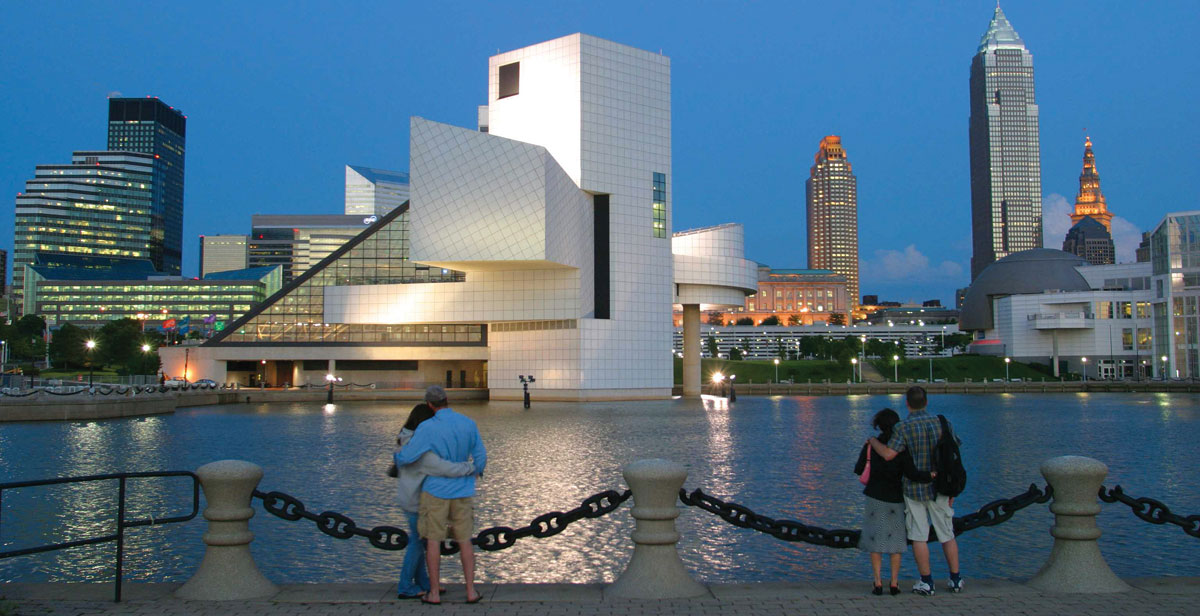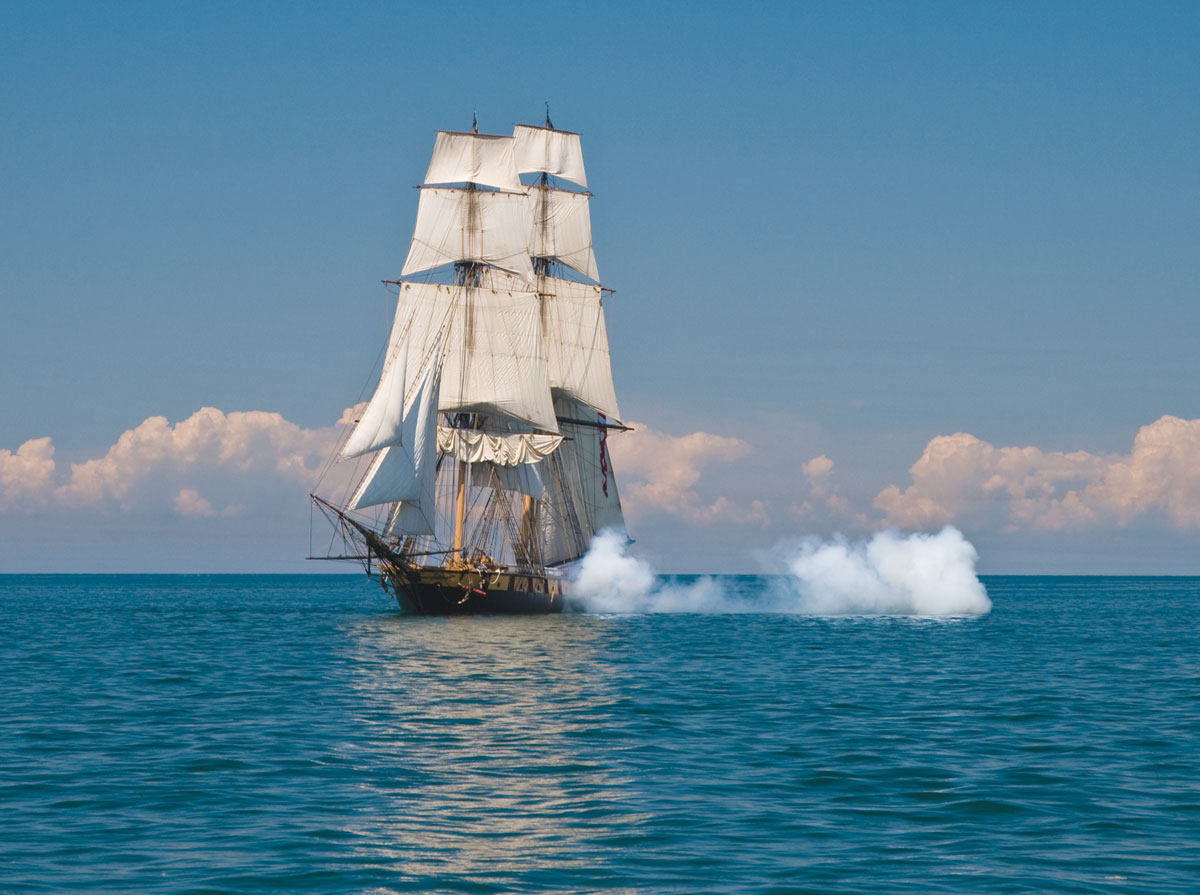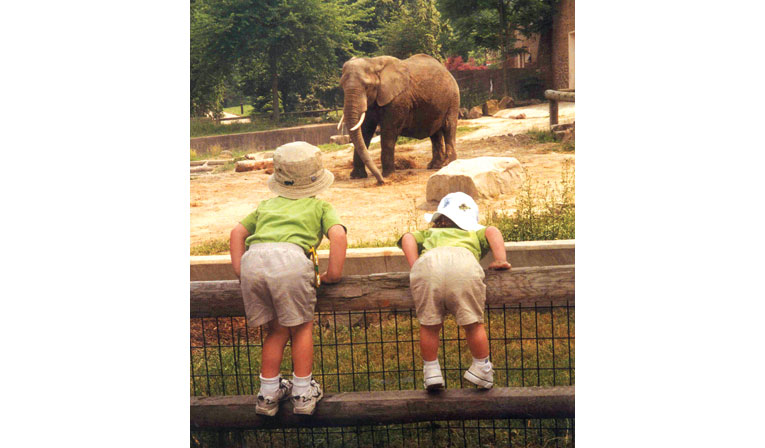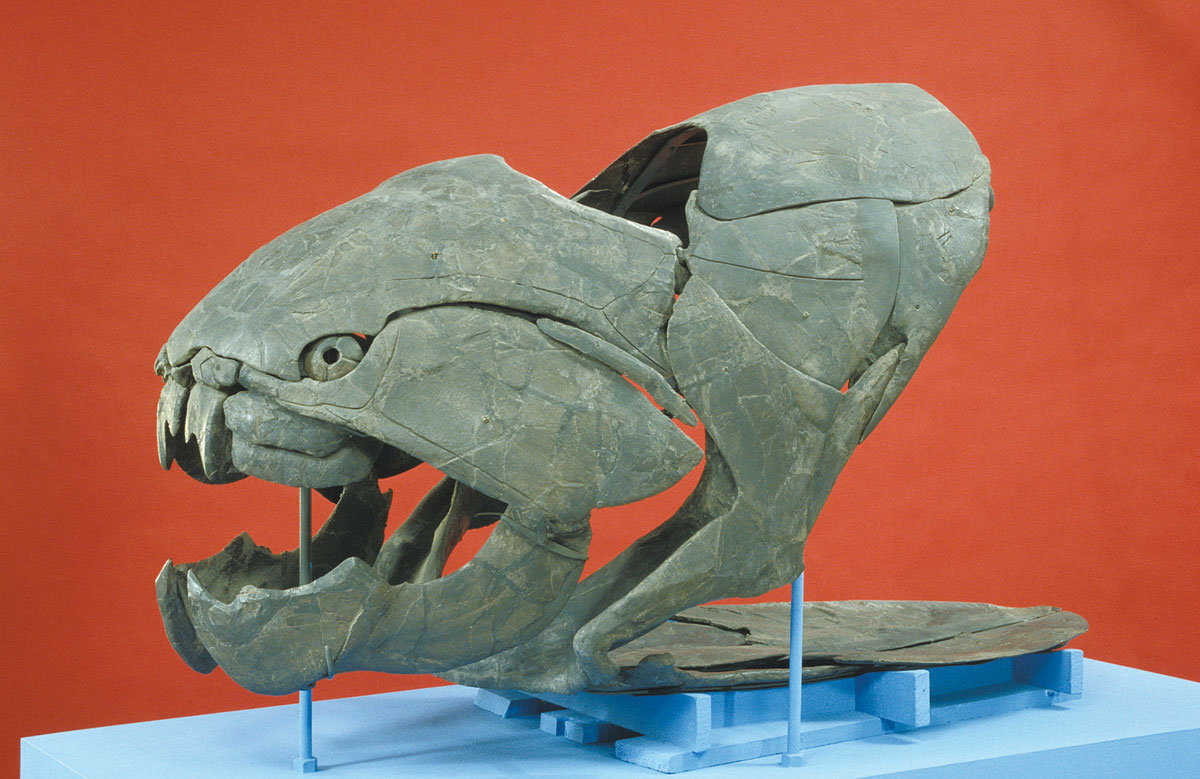Photo courtesy of PositivelyCleveland.com
Best known for the Rock and Roll Hall of Fame and Museum, this Ohio city offers the boating public an exclusive backstage pass to its many waterfront attractions and treasures.
Big city attractions are just steps from the dock when you tie off in Cleveland, Ohio. Whether you’re a Great Lakes history buff, a sports fanatic, or just part of an adventuresome family, there’s much to see and do in this evolving city — with fantastic accessibility for boaters.
When considering Cleveland, many think first of the Rock and Roll Hall of Fame and Museum rather than, let’s say, breathtaking sunsets to rival those found on the Atlantic coast of Western Ireland.
But here’s where it helps to have a local guide like Brendan Ring. Ring is the owner of Nighttown, a restaurant, bar and jazz club that has been a Cleveland institution since 1965. He’s also an avid boater who happened to grow up on the Irish seacoast.
From downtown Cleveland’s shoreline you can watch the sun disappear beyond the horizon into Lake Erie or, from the east side, see it set behind the skyline in the spring and fall, according to Ring.
“The skyline of Cleveland is fantastic at sunset,” says Ring, whose father was a charter boat captain in Ireland. “You can sit out there with a bottle of wine and watch the sunset, watch the freighters come in… I grew up in Western Ireland and thought I’d seen beautiful sunsets.”
Because Nighttown is located near the world-renowned Cleveland Clinic medical center, Ring says he takes the opportunity to give anyone from new doctors to visiting jazz musicians a ride on his 25-foot Sea Ray bowrider to get to know the city from the water.
“They’re always floored when you take them out on Lake Erie,” says Ring, who moved to Cleveland from New York City with his wife 20 years ago. “First of all, because of how big the lake is and, second of all, how beautiful the lakefront homes are.”
Whether scoping the lavish homes of the robber-barons, running offshore to fish, anchoring to swim at a local beach, or exploring the Rust Belt city’s history by cruising its network of rivers, Ring and other locals have a laundry list of on- and off-water activities for visiting boaters to tackle.
A city in transition
Though the popular image of Cleveland is intertwined with its industrial past, the city has undertaken redevelopment projects in several stages since the 1980s. Some have fizzled — the “Flats,” on the banks of the Cuyahoga River, hosted myriad music venues, bars and restaurants through the ’90s and is now going through a re-redevelopment phase focusing on mixed-use projects — while others, such as the great civic attractions on the Lake Erie waterfront and the booming nightlife of the Warehouse District, continue to build on their successes.
Tower City Center, the grand converted downtown train terminal that boasts a mall, restaurants, movie theaters, office buildings, hotels, and a casino, is located near the Cleveland Cavaliers’ basketball arena and Indians’ baseball stadium on Public Square, across the Cuyahoga River from Riverfront Yacht Sales & Services. This well-established boatyard, dealership and yacht broker has been serving boaters for 25 years. The are known for quality craftmanship and technical services. Riverfront offers both indoor and outdoor storage and can complete all of your winter repair or retrofitting projects.
“After having boated in the Cleveland area for nearly 40 years, I am still amazed at the people — boaters and non-boaters — who don’t have a clue about how good boating and fishing opportunities are in Cleveland,” says Norm Schultz, a boating industry consultant who served as president of the Lake Erie Marine Trades Association, which is based in the Cleveland suburb of Westlake, for more than three decades. “When the city finally gets the new transient docks installed in the North Coast Harbor, for example, boaters will be able to dock downtown in the heart of the city and walk to everything from theaters to restaurants to sports stadiums.
“There’s also a rapid transit station right near the harbor that can take visitors just about anywhere in the city,” says Schultz.

Photo courtesy of PositivelyCleveland.com
The War of 1812 in the Great Lakes
 The U.S. Navy, Marines, and Coast Guard will commemorate the bicentennial of the War of 1812 throughout the Great Lakes with events planned from Milwaukee to Buffalo, New York, in August and September. Events are timed to coincide with Navy Week celebrations.
The U.S. Navy, Marines, and Coast Guard will commemorate the bicentennial of the War of 1812 throughout the Great Lakes with events planned from Milwaukee to Buffalo, New York, in August and September. Events are timed to coincide with Navy Week celebrations.
In Cleveland, Navy Week and the bicentennial commemoration will be held in conjunction with the Cleveland National Air Show. The Air Show includes flight demonstrations by the U.S. Navy Blue Angels and three ships will partcipate in a traditional “Pass-in-Review.”
The U.S. Brig Niagara will be among the Navy and Coast Guard ships on display in Toledo, Cleveland, Detroit, and Buffalo. The reconstructed tall ship is of great historical significance as it was the relief flagship of a fleet which defeated the British in the Battle of Lake Erie at Put-in-Bay, Ohio, in 1813, giving the United States control of the lake for the remainder of the war.
Schedule of Bicentennial Events:
Milwaukee: August 8-13
Chicago: August 15-20
Toledo: August 22-27
Cleveland: Aug. 27-Sept. 4
Detroit: September 5-10
Buffalo: September 12-17
For more information on the bicentennial of the War of 1812, visit www.ourflagwasstillthere.org
Photo by John Baker, courtesy of Flagship Niagara League
Photo courtesy of Great Lakes Science Center
On the waterfront
North Coast Harbor is located smack in the middle of downtown Cleveland and really sprang to life in the 1990s with the openings of the Rock and Roll Hall of Fame and Museum (1995), Great Lakes Science Center (1996) and Cleveland Browns Stadium, where the city’s revived National Football League franchise plays (1999).
Boaters have unparalleled access to the area, according to Dante Centuori of the Great Lakes Science Center (GLSC).
“There’s a bulkhead right behind the science center,” says Centuori, GLSC’s director of creative productions. “If you have a boat, you can dock right behind it.”
Centuori cautions that there’s only about 5 to 6 feet of draft in this area and that overnighting is not allowed. But boaters interested in a day trip can tie up mere feet from the GLSC.
There they can tour a significantly larger craft, and one of the redeveloped harbor’s first attractions, the retired steamship William G. Mather. This 618-foot ore boat, called “the ship that built Cleveland,” is now docked and operated as a museum by the GLSC. Centuori, therefore, is closely involved with exhibits, which explore the ship’s history and the history of Great Lakes shipping.
“The Mather was actively shipping from 1923 to the early 1980s,” he says. “For about half that time she was the flagship for the Cleveland-Cliffs Iron Company.
“In her heyday, she brought so much taconite that the moniker ‘the ship that built Cleveland’ is almost literal — the taconite went right into the steel mills that produced much of the city’s infrastructure.”
The Mather is also historically significant as an early adopter of such technological upgrades as steam turbine engines, onboard computer controls for the boilers, and radar. Interestingly, some areas of the ship were restored to original 1920s condition, while other areas remained as they were in the ’70s. New exhibits include the Great Lakes Story, a history of shipping, and a behind-the-scenes “hard-hat tour.” In addition, the GLSC hosts the traveling Titanic exhibit in 2013.
“So next summer we’ll be very ‘boaty’ between the Mather and the Titanic exhibit going on inside,” says Centuori.
The Mather is open daily from June to August and weekends from May to October, while the science center is open daily year-round. In addition, special tickets are available to view the Cleveland National Air Show from the deck of the Mather over Labor Day Weekend. Planes take off from Burke Lakefront Airport, which is located on the eastern edge of North Coast Harbor. The U.S. Navy Blue Angels and the U.S. Army Golden Knights precision parachuting team will perform. Visitors can also go inside the planes and meet their pilots.
Whiskey Island evolution
To the west of the harbor lies Whiskey Island Marina. Whiskey Island was named after an Irish settlement that featured bars serving whiskey, according to Tim Poole, general manager of the present-day marina’s restaurant and bar, the Sunset Grille, as well as neighboring Wendy Park nature preserve.
Later, during Prohibition, the island was a clandestine entry point for Canadian liquor. In the years since, it has been home to many businesses — most recently a salvage company, according to Poole — before a group of investors sought to turn it into a pristine park and marina.
Happily, they succeeded in creating a vibrant space with beaches, lakefront, riverfront, wooded areas, and a public marina complex. There’s even a stunning art deco Coast Guard station on Whiskey Island that’s under renovation.
“The goal was to create value down here for the public, and I think we’ve done that,” says Poole. “They can ride their bikes, come by car, come by boat — it’s a unique venue with a very cool vibe.”
Access is not only open, but unique: Soon bicyclists will be able to ride from Cincinnati to Wendy Park on the Ohio to Erie Trail, while boaters can anchor off the beach and swim up or take advantage of a handful of guest docks.
“It’s very important that when someone comes down here they feel comfortable,” Poole adds. “It’s like a big party, and it’s very diverse. Everyone is welcome here.”
For overnighters, the marina has a limited number of transient docks, according to marina operations manager Tom Lawson. (Whiskey Island’s permanent slips have been sold out for years.) But there are a half-dozen or so additional marinas in and near downtown, he says.
“There’s plenty of transient dockage for people to visit Cleveland,” says Lawson. “If we’re full, we’ll recommend other places to go.”
John Sima, president of Sima Marine, a boat sales and service yard near Cleveland, agrees. “Cleveland is a great protected harbor, and there are a number of places you can get guest and transient docks such as the Edgewater Yacht Club, Lakeside Yacht Club and Forest City Yacht Club,” says Sima. “And those are all inside the breakwater. There are good harbors either side of Cleveland, too.”
Sima Marine, founded by Sima’s father in 1956, is located about 20 miles up the shore in Eastlake, Ohio.

Photo courtesy of PositivelyCleveland.com
Out to launch
Boaters who prefer trailering will find Cleveland welcoming, too. The Cleveland Metroparks Zoo is located on the west side a few miles from the water, and that doesn’t bother Jim Nemet, a senior education manager in charge of animal shows at the zoo who is also a dedicated trailerboater. He fishes and cruises all around the area in his outboard-powered 27-foot Glasstream center console.
“There are ample places to launch your boat,” says Nemet, “and with the breakwater being there, if it’s choppy on Lake Erie you can stay inside.” He says his typical routine includes taking a historical trip up the Cuyahoga River and then heading straight out into Lake Erie for a swim.
Other highlights include viewing the eclectic houses and old bridges of the Rocky River, watching freighters use their thrusters to get around tight corners in the rivers, and exploring the city’s waterways in general.
“It’s very visually stimulating,” says Nemet, who grew up here fishing for perch with his father.
“My love of water and boating started my love of marine animals,” he says. “I worked at Sea World and spent every day swimming with animals, and that transferred to my love of all animals.”
The zoo is open daily, including extended evening hours on weekends and holidays from Memorial Day to Labor Day.
More sights to ‘C’
Five miles east of downtown — and well worth the cab fare or rapid transit bus ride —is the University Circle area. Here you’ll find the Cleveland Museum of Natural History, Cleveland Museum of Art, Cleveland Children’s Museum, Cleveland Institute of Music, Cleveland Orchestra, Western Reserve Historical Society, Case Western Reserve University, and much more, including green space, gardens and a tranquil lagoon.
This is the same part of town where you’ll find the Cleveland Clinic and a variety of dining, shopping and entertainment options. Nearby, you can even drop into Brendan Ring’s Nighttown — which he notes is open late seven nights a week — for a bite to eat and a show.
Sheryl Hoffman is director of major and planned gifts and government relations at the Cleveland Museum of Natural History. She has also been on the water since before birth — her mother was waterskiing at nine months pregnant, she says. Like so many others in the Cleveland area, Hoffman’s professional and volunteer work life ties back to the water and to nature.
The museum was founded in 1920.
“It’s a pretty incredible natural history museum,” says Hoffman, a sailor who grew up on powerboats, crews on a Frères 33 out of Lakeside Yacht Club in Cleveland, and owns a 26-foot Pearson. “We have a fabulous planetarium, real dinosaurs, and we also have live animals.”
The two acres of live animals focus on the animals of Ohio, she says, and the museum stewards 5,000 acres throughout Northeast Ohio.
“It’s all land that’s important to wetland preservation, to water quality, as well as habitat for endangered species, both flora and fauna,” says Hoffman.
Hoffman and the museum are also involved with the Great Lake Erie Boat Float, held each September at Cleveland’s Edgewater State Park Beach, in which children and volunteers build boats out of discarded plastic materials to raise environmental awareness.
And it’s true that Clevelanders are willing to confront the less-attractive aspects of the city’s industrial past: For instance, the Great Lakes Brewing Company and the Burning River Foundation co-host the Burning River Fest, held each year at the Whiskey Island Coast Guard station, to promote environmental awareness and ecological conservation by commemorating the Cuyahoga River fire of 1969.
In addition to the many educational institutions located in the University Circle area, the Greater Cleveland Aquarium opened this year on the West Bank of the Cuyahoga River in the Flats neighborhood. The indoor aquarium occupies part of the historic FirstEnergy Powerhouse, a former power station that also hosts banquets, meetings and other events. Outdoor concert venue the Jacobs Pavilion is next door to the Powerhouse — all accessible by boat — and is another mark of the revitalization of the Flats, while across the river on the East Bank the newly built Ernst & Young building is the latest addition to downtown. Further redevelopment of the East Bank is also planned.
As for Hoffman, she keeps her 1977 Pearson 26 on Lake Erie in Sandusky — where she sits on the boards of both the Sandusky Sailing Club and the Sandusky Junior Sailors — which is less than an hour by car from Cleveland.
“If someone wanted to sail or cruise to Cleveland, they can easily spend a week visiting the zoo and the museums and University Circle,” says Hoffman. “Then you have Playhouse Square with all the fabulous theater. You cannot get bored in Cleveland, that’s for sure, and the best thing is it’s affordable — and friendly.”
Work, live, boat
MidTown is the corridor between downtown Cleveland and University Circle. Jeffery Pesler, assistant director of MidTown Cleveland Inc., is tasked with attracting businesses to the area.
“We’re the connective tissue between those two anchors,” Pesler says. “We’re trying to reestablish that vibrant fabric that’s sort of been lost over the last couple decades.”
While Cleveland and other Rust Belt cities experienced a downtown renaissance in the mid-1990s, he says, they also lost much of the industry the towns were built upon. To replace them, Cleveland is attracting major investment in the health care industry, IT and software development.
“It’s a city headed in the right direction, and there’s a lot to be excited about,” says Pesler, who notes that there’s a waiting list for apartments downtown.
Pesler lives in the Gordon Square Arts district, just a mile and a half from the marina where he keeps his 38-foot Island Trader ketch.
“There are very few places where I could live in a city and live so close to the boat as cheap as I do,” he says. “It’s very inexpensive to be a boater in Cleveland. As a matter of fact, I rarely drive my car to the marina — I usually bike down.”
Some of his favorite excursions include exploring the rivers, bridges and other vestiges of the city’s industrial heritage; “poaching” a live concert outside Jacobs Pavilion; or simply taking a late-afternoon sail after work with colleagues and friends.
“And there’s no better place to be for the air show on Labor Day Weekend than on the lake,” says Pesler.
Civic pride
The boating season in Cleveland comes to an end with the November gales, which Nighttown owner Ring lists alongside the city’s incredible sunsets and eventual winter freeze — “It freezes on the last crash of wave and holds it for the winter,” he says — among his favorite natural characteristics of Cleveland.
Ring sums up the feelings of many Cleveland boaters.
“I wouldn’t want to be anywhere else, honestly.”
Cleveland Fossils!
 Long before the city — or humans, or even dinosaurs — existed, the Cleveland area was covered by a great shallow sea teeming with life. Hundreds of millions of years later, the fossilized remains recovered here have made Cleveland and the Cleveland Museum of Natural History a paleontological hotbed.
Long before the city — or humans, or even dinosaurs — existed, the Cleveland area was covered by a great shallow sea teeming with life. Hundreds of millions of years later, the fossilized remains recovered here have made Cleveland and the Cleveland Museum of Natural History a paleontological hotbed.
“Once upon a time — 360 million years ago — Cleveland was under an ocean,” says the museum’s Sheryl Hoffman. “So we have one of the best collections of shark and Dunkleosteus fossils in the world.”
A giant armored fish, the Dunkleostus grew up to 30 feet in length and could “snap a prehistoric shark in two with its razor-sharp jawbones,” according to the museum. Luckily, they are not found in Lake Erie today, having gone extinct in the Carboniferous period.
Photo courtesy of The Cleveland Museum of Natural History





